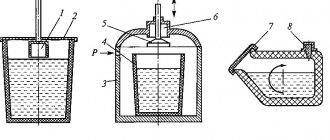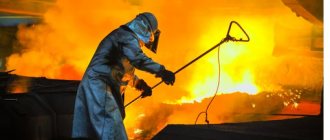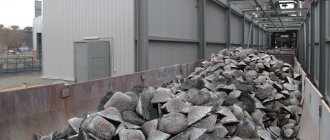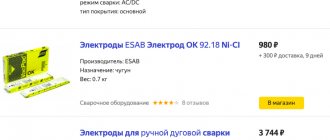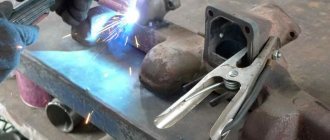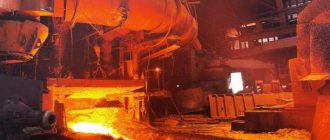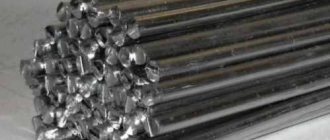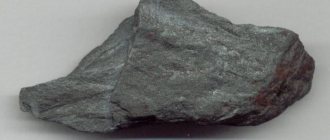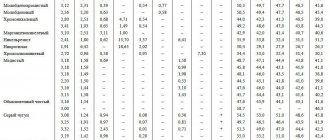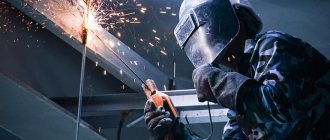High-strength nodular cast iron or ductile iron is a structural material with high strength properties and good performance characteristics. As is known, in cast iron the shape of the graphite grain has a decisive influence on the strength characteristics of the material. In high-strength ductile iron cast iron, graphite inclusions have a spherical shape*. As a result, ductile iron has significantly superior mechanical properties to gray cast iron and successfully competes with steel.
High-strength nodular cast iron compares favorably with steel due to its good casting properties (high fluidity, low tendency to form hot cracks, less shrinkage, etc.), relative simplicity of the smelting process and lower cost.
*Spherical graphite is also called spheroidal or globular graphite.
From the history of high-strength nodular cast iron (ductile iron)
At the 1943 American Foundry Association (AFS) Convention, JW Bolton fantasized about controlling the shape of graphite in gray cast iron. A few weeks later, the American Keith Dwight Millis in the research laboratory of the International Nickel Company (INCO) made the following discovery: when magnesium is added to the molten cast iron in a ladle, the casting produces not flake graphite, but graphite of an almost ideal spherical shape.
Based on the above, we can actually consider 1943 to be the year of birth of high-strength nodular cast iron (ductile iron). Our sources [1] call the birthday of high-strength cast iron May 7, 1948, when a congress of American foundry workers took place in Philadelphia and a public announcement was made about the production of high-strength nodular cast iron.
However, the authors of [2] tend to consider the official birthday of high-strength nodular cast iron to be a later date, namely October 25, 1949, when Keith D. Millis received a patent for high-strength nodular cast iron (ductile iron) number 2485760 ( Cast ferrous alloy).
In those same years (1948-1949), this direction began to actively develop in Kyiv and Moscow: scientific schools were created to develop technologies for producing ductile iron and study the properties of high-strength cast irons...
©ICM (www.modificator.ru)
It should be noted that the Russian standard for high-strength cast iron, GOST 7293-85, despite the name “ Nodular cast iron for castings”
» extends its effect to both high-strength cast iron with nodular graphite (ductile iron) and high-strength cast iron with vermicular graphite (ductile iron).
Types of malleable cast iron
The grade of cast iron alloy KCh is directly related to the conditions under which annealing is carried out. After this operation, three classes of cast iron are obtained:
- ferritic;
- pearlite;
- ferritic-pearlitic.
The first contains in its chemical composition ferrite and carbon of a flocculent structure. The second includes pearlite and graphite with a flocculent structure. The third contains ferrite, pearlite and flake-like carbon.
Types of malleable cast iron
Malleable pearlitic cast iron results from rapid cooling of the workpiece while it is in the decomposition zone. In this case, in addition to ferrite, the structure of cast iron will contain pearlite. It will persist even with further cooling of the workpiece to a temperature lower than 727 degrees.
That is, we can say that the structure of cast iron is strictly related to the annealing temperature conditions and the presence of alloying components.
Properties of ductile iron
The properties of high-strength cast irons are very diverse, but a distinctive feature of such cast irons is the combination of good casting properties and high strength characteristics. The properties of high-strength cast iron also include: good cutting performance, high ductility, low sensitivity to stress concentrators, and resistance to cyclic loads.
Casting properties of high-strength cast iron, in particular ductile iron:
- high fluidity,
- low tendency to form hot cracks,
- small shrinkage.
The requirements for the mechanical properties of high-strength cast iron are regulated by the GOST standard 7293-85 (ST SEV 4558-84).
Main characteristics of the metal
The key parameters of cast iron are determined by the amount of carbon, which has the form of graphite, and the presence of silicon. Pearlitic malleable cast iron alloy contains two more constituent elements - chromium and manganese.
Characteristics of Ductile Iron
The difference in the structure of malleable cast iron is also reflected in the final properties of products obtained from it. For example, workpieces made from ferritic cast iron have lower hardness than those made from pearlitic material, but at the same time the former have increased ductility. Graphite in the form of flakes provides high strength parameters to finished parts with relatively good ductility. Products made of KCh cast iron can be deformed at room temperature and humidity. It was this property that determined the name of this material – malleable. In fact, this is a conditional name and does not mean that finished parts are obtained from it using forging equipment. Casting is used to produce products. The main property of this material is that there is no stress in it.
Microstructure of ductile iron
The mechanical properties of ductile cast iron are between gray cast iron and steel. That is, cast iron of this type has high fluidity, resistance to wear, corrosion, and aggressive substances. In addition, this material has high strength properties. Thus, a part with a wall thickness of 7–8 mm can withstand working pressure of up to 40 atm. This allows it to be used for the manufacture of pipeline fittings for gas and water.
We must not forget that at low temperatures, cast iron becomes very brittle and is very susceptible to impact.
Application of high-strength cast iron
Castings weighing from tenths of a kilogram to several tens of tons are made from high-strength cast iron with nodular graphite. The properties of ductile iron are very diverse, so high-strength cast iron is used:
- instead of gray cast iron - to extend the service life of castings (molds, rolling rolls, pistons, piston rings, etc.);
- instead of steel - in order to simplify and reduce the cost of production, reduce the amount of metal and rationalize the design of castings (crankshafts, traverses, gears, etc.);
- instead of non-ferrous alloys - in order to reduce the consumption of scarce metals and reduce the cost of machines.
Along with structural high-strength cast irons, high-strength cast irons with special properties are used: heat-resistant and growth-resistant (for example, see Niresist), resistant in various aggressive environments, anti-friction high-strength cast iron with a low coefficient of friction, etc.
area of application of ductile iron today
is the production of ductile iron pipes.
©ICM (www.modificator.ru)
Features of the production of malleable cast iron
The production of KCh cast iron has a number of subtleties that are determined by casting characteristics and other properties.
Ductile iron production
Cast iron of the BC grade, which is the main product of malleable iron, does not have very good casting parameters. In particular, it has reduced fluidity, a large amount of shrinkage during cooling, and it is prone to the formation of various casting defects. These are the reasons why during production it is necessary to overheat the metal and take measures to combat casting defects. The production of malleable cast iron can be carried out with the obligatory consideration of shrinkage and changes in the dimensions of the workpieces during simmering. Thin workpieces have maximum shrinkage, thick ones have minimal shrinkage. The simmering operation is performed at 1350 - 1450 degrees Celsius.
Annealing (simmering) is a basic step in the production of cast iron. It is produced in separate workshops called languid. The preparations are placed in pots made of steel or cast iron alloys of different grades for simmering. Up to 300 castings can be placed in a pot, based on the fact that up to 1,500 kg should be per cubic meter.
Malleable cast iron gains its greatest strength in pots made from white cast iron with chromium additions and a minimum amount of phosphorus. The consumption of pots is measured by weight; it can range from 4 to 15% of the weight of the workpieces. That is why increasing their durability plays a big role in determining the cost of finished malleable cast iron.
To avoid warping of the finished castings, placing the blanks in pots must be done with special care. They are laid as tightly as possible; to enhance the effect, the workpieces are sprinkled with sand or ore. These materials protect the workpieces from deformation and excess oxidation.
Iron production
Electric furnaces are used to produce malleable cast iron. This is due to the fact that during the simmering process it must be possible to regulate the temperature, a sharp rise during heating and a rapid decrease at the stage of its graphitization. In addition, it will not be superfluous to be able to adjust the air mixture in the oven.
Most of the furnaces used to produce malleable cast iron are muffle furnaces. That is, the products of fuel combustion do not come into contact with the pots in which the workpieces are placed.
Castings made from malleable iron go through a cleaning operation several times, and after annealing, feeders are removed and straightened. The first cleaning is carried out to remove residual molding sands. For cleaning, sandblasting equipment or special tumbling drums are used. Removal of feeder residues occurs using emery cloth.
Malleable cast iron defects
The most common defects in malleable cast iron are the following:
- shrinkage cavities;
- underfilling;
- cracks, etc.
Some defects cannot be corrected by further heat treatment. It should be noted that the production of malleable cast iron requires strict compliance with all GOST requirements, technological rules and regulations. Only in this case can we talk about obtaining high-quality malleable cast iron, which can be used to replace other, expensive materials - steel, non-ferrous metals.
The meaning and method of applying cement-sand coating
The cement-sand coating (CSC) method is used in industrial areas, residential areas and places where there are underground communications to save money during the reconstruction of damaged pipelines.
During operation of a pipeline that has been treated with CPP, a hydrophilic ball is formed, thanks to which leaks are sealed and all defects in the pipe are removed. According to GOST standards, the pipeline restoration technology by applying CPP is used for the following purposes:
- Preventing the formation of plaque inside the pipe;
- Prevention of corrosion formation;
- Sealing joints;
- Increased service life.
Installation of ductile iron pipes
Cement-sand coating (CSC) is a solution of cement and sand, which is applied to the inside of the pipeline by centrifugal spraying. An important advantage of this method of protection is the low cost of materials (sand and cement).
The cement-sand coating method (CSC) is regulated by GOST and is used when rehabilitating old and worn-out pipelines. Such work significantly saves time and financial costs compared to laying new pipes. CPP is also applied to new cast iron pipes for utility, agricultural and industrial applications. Due to its microbiological properties, CPP serves as the best material for water supply systems. During installation, cast iron pipes are built up gradually, observing all the conditions of the design documentation.
Cast iron pipes do not require significant installation effort and are easy to use.
